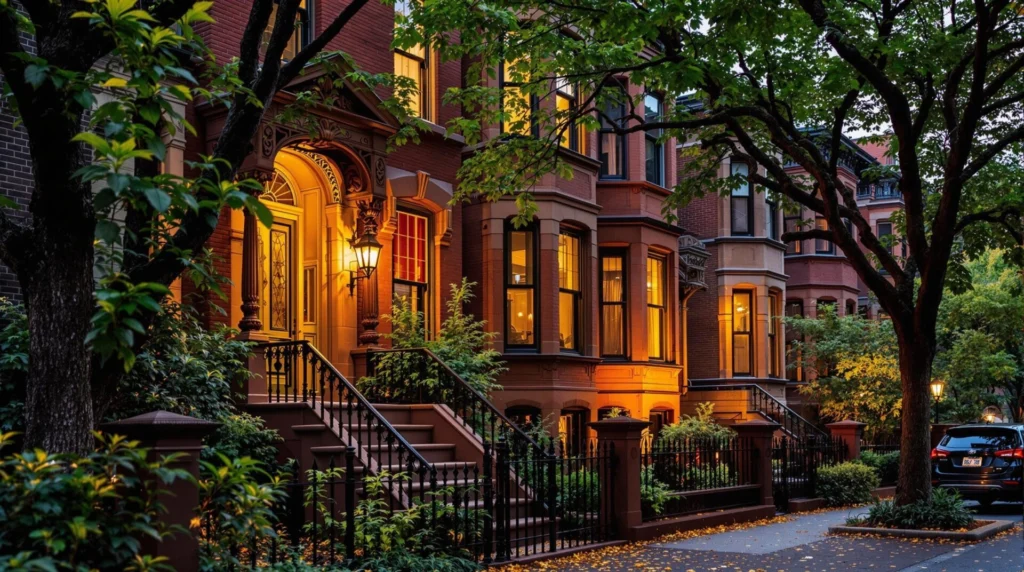Key Takeaways:
- Millennials and Gen Z are driving the demand for sustainable properties, making them a critical focus for future investments.
- Government incentives are playing a significant role in making green buildings more economically viable.
- The convergence of consumer demand, technology, and policy will unexpectedly reshape the real estate landscape.
The Future of Real Estate: A Sustainable Shift
You’re about to witness a shift in real estate investing as sustainable properties take center stage by 2025.
With Millennials and Gen Z prioritizing eco-friendly living, these properties aren’t just a trend—they’re a necessity.
Governments are rolling out incentives, making green buildings more appealing and economically viable.
But how will these changes influence property values and your investment strategy?
What challenges might arise in eco-friendly construction?
As you explore these questions, consider how the convergence of consumer demand, technology, and policy will reshape the real estate environment in ways you might not expect.
Market Dynamics and Consumer Demand
The real estate market is undergoing a significant transformation as sustainable properties gain popularity.
You’re witnessing a shift where sustainable architecture and eco-friendly materials aren’t just buzzwords but essential elements driving market dynamics.
Sustainable developments are expanding beyond luxury markets to affordable housing initiatives, making sustainability accessible to a broader audience.
As a savvy investor, you’re probably noticing the rising demand for energy-efficient homes.
Features like solar panels and smart home technology aren’t just trendy; they’re becoming must-haves.
This movement isn’t fleeting—it’s reshaping the industry’s terrain. Builders are increasingly adopting green practices and utilizing eco-friendly materials in new constructions.
Imagine older homes boosted in value simply by integrating green upgrades.
It’s not just about following a trend; it’s about staying ahead in a rapidly evolving market.
The green real estate sector is expanding, with consumers keen to pay extra for homes that align with their environmental values.
You see, buyers today prioritize energy-efficient appliances and superior insulation, making these features key selling points.
Traditional properties without these green elements risk becoming obsolete.
But here’s where you can make a difference—by retrofitting existing buildings with sustainable features, you enhance their market value. Welcome this green revolution.
It’s not just about investing in properties; it’s about investing in a future that values sustainability and independence.
Your role?
Lead the charge, and watch your investments thrive.
Government Incentives and Economic Benefits
As sustainable properties reshape the real estate terrain, you’ll find that government incentives play a pivotal role in this shift.
Governments offer tax rebates for energy-efficient upgrades, reducing financial barriers and boosting eco-friendly investments. Builders using sustainable materials get subsidies, making green homes more accessible.
This government support not only eases the initial financial load but also accelerates the market’s shift toward sustainability.
Furthermore, the demand for retrofitting existing homes with eco-friendly features is rising, driven by advancements in green technology.
You also benefit from incentives like VAT exclusions for energy-efficient features, alongside loan programs that provide essential support for developers.
These measures guarantee that sustainable building practices become the norm. Green certifications, backed by policies, mean homes with lower operating costs and environmental impact command market premiums.
With India leading in Asia, the adoption of renewable energy and green certifications is on the rise, aligning with global trends.
All these initiatives highlight the financial advantages of investing in sustainable properties.
On the economic front, sustainable properties offer long-term cost savings through reduced utility bills and yield premium valuations, enhancing your investment returns.
This burgeoning market is set to grow, driven by government incentives and a rising demand for green living spaces.
As a result, sustainable buildings create jobs and stimulate innovation, positively impacting the economy.
Welcoming this green wave offers not just economic benefits but also aligns you with the future of real estate.
Technological Innovations in Green Building
Innovations in green building technology frequently reshape how properties are designed and constructed, offering you a more sustainable future.
Welcome the power of smart technology, where solar panels convert sunlight into electricity, slashing your reliance on traditional power sources.
LED lighting shines brighter and longer while consuming less energy, reducing waste and cost. Smart thermostats take the guesswork out of climate control, adjusting temperatures based on occupancy, ensuring ideal energy efficiency.
With energy-efficient buildings capable of decreasing energy usage for heating, cooling, and lighting, you can enjoy lower utility costs and contribute to reduced greenhouse gas emissions.
Rainwater harvesting systems and energy-efficient windows are game-changers in reducing your property’s environmental footprint.
By capturing rainwater, you minimize your dependence on municipal water, while advanced windows keep your building insulated, cutting down on heating and cooling needs.
The combination of passive and active tools fosters holistic green projects, enhancing the overall sustainability of your construction endeavors.
The adventure of sustainable construction doesn’t stop there. Cross-laminated timber (CLT) offers a robust, eco-friendly alternative to concrete and steel, slashing construction times and carbon footprints.
Cool roofs and smart glass reduce the need for air conditioning, while IoT devices collect data to enhance energy use.
Smart HVAC systems and building automation systems work tirelessly, managing energy consumption efficiently.
With these innovations, you’re not just building properties—you’re crafting a sustainable legacy, empowering a greener real estate investment environment.
Challenges in Eco-Friendly Construction
Maneuvering the domain of eco-friendly construction presents a maze of challenges that can leave even the most seasoned investors cautious.
You face hurdles in finding skilled labor, as limited expertise in green technologies and sustainable materials can drive up project costs and delay timelines.
Tackling these issues requires extra training for construction workers, which can be expensive and time-consuming.
Inadequate labor not only impacts budgets but can also compromise the energy efficiency and environmental performance of your buildings.
When sourcing sustainable materials, you might find their availability restricted, with some only accessible in specific regions.
This geographical constraint can inflate costs and limit your design options. The inconsistent quality of eco-friendly materials further complicates things, as added testing and verification are often necessary.
You’re left traversing a limited selection, which challenges your creativity and design flexibility.
Moreover, some sustainable materials remain in early development stages, affecting their availability and increasing their cost compared to traditional alternatives.
As the demand for certified buildings increases, real estate investors are more inclined towards properties that can command higher rents and meet stringent sustainability standards.
Understanding and meeting varying standards and certifications adds another layer of complexity.
With no universal definition of a sustainable building, you may feel lost among multiple certification systems.
You need clearer guidelines to confidently design and construct eco-friendly buildings.
Confront these challenges as opportunities to innovate and lead in the green real estate revolution.
Future Benefits and Investment Trends
Steering through the complexities of eco-friendly construction might seem intimidating, but the horizon of sustainable real estate investment is filled with promising opportunities.
By 2025, 82% of new urban residences will harness smart technology, revolutionizing energy efficiency. Imagine the potential for cost savings with green buildings using advanced HVAC systems and renewable energy.
You can reduce utility bills and maintenance costs while minimizing carbon footprints with sustainable materials.
The built environment currently contributes nearly 40% of global energy-related carbon emissions, emphasizing the critical need for sustainable practices in real estate.
Energy audits guarantee your properties stay efficient, boosting their long-term value.
Additionally, tax breaks for sustainability offer financial incentives, allowing property owners to price their buildings at a premium while benefiting from reduced operational costs.
Sustainable properties aren’t just about cutting costs; they also increase property value. With green certifications like LEED and BREEAM, your properties become more desirable. These features attract eco-conscious buyers, leading to higher rental yields.
Climate-resilient designs and community green spaces further enhance property appeal and valuation.
The market’s shifting, driven by consumer demand and awareness.
The Asia-Pacific region is leading the charge, while the Indian market is on a trajectory to reach $1 trillion by 2030.
Millennials and Gen Z prioritize sustainability, making your investments future-proof.
The sustainable real estate market‘s growth, supported by tech advancements, offers you a chance to innovate and thrive.
Accept this green revolution and secure your place in the future of real estate.
Frequently Asked Questions
What Are the Key Drivers of Sustainable Property Investment Growth in 2025?
Imagine a bright future where sustainable technology thrives. You’ll see irresistible investment incentives driving growth. Regulatory pressure and market demand propel the shift. Tenant expectations and financial perks create a perfect storm for sustainable property investment in 2025.
How Do Sustainable Properties Impact Community Development and Local Economies?
You see sustainable properties driving community engagement and boosting economic resilience. They create jobs, enhance local spending, and improve quality of life, all while reducing environmental impact and nurturing a sense of collective responsibility and progress.
What Role Do International Investors Play in the Sustainable Real Estate Market?
You drive sustainable real estate by using strategic investment strategies, prioritizing properties with eco-friendly credentials. Your international collaboration influences developers to adopt green practices, ensuring consistent global standards and making sustainability a key market trend.
How Is Sustainability Influencing Property Management and Maintenance Practices?
You’re seeing sustainability reshape property management by focusing on energy efficiency and waste reduction. Implement energy-efficient appliances and smart technologies to minimize consumption, while promoting recycling programs and regular maintenance to reduce waste and prolong material life.
What Are the Emerging Trends in Sustainable Property Financing Options?
Imagine green bonds as seeds planted today, yielding tomorrow’s sustainable forests. They’re enthralling impact investing enthusiasts by promising eco-friendly returns. You’re witnessing a shift, where these sustainable financing options increasingly define real estate’s future, attracting conscious investors.
Realize That the Green Revolution in Real Estate Is Coming!
As you stand at the brink of a new era in real estate, where sustainable properties transform investment strategies, it’s crucial to take action. Imagine energy-efficient homes not only reducing costs but also boosting your property’s value.
Picture government incentives as the fuel for your eco-friendly journey. While challenges exist, innovation in green building lights the way forward. You’re not just an investor; you’re a pioneer.
Welcome this adventure and seize the opportunity.
Remember, your actions today shape a sustainable, profitable tomorrow.
Dive into this green revolution, lead the charge, and be the change you want to see in the world of real estate.





















